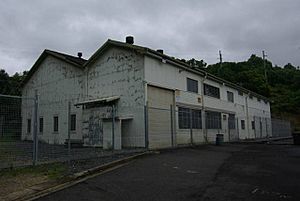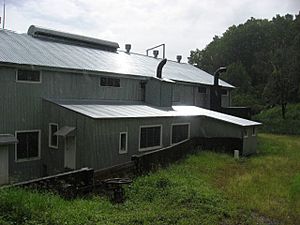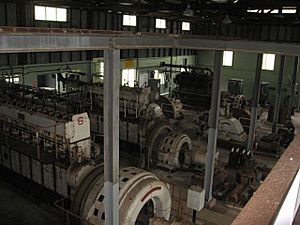Mullumbimby Hydro-electric Power Station Complex facts for kids
Quick facts for kids Mullumbimby Hydro-electric Power Station Complex |
|
|---|---|

Entry to Mullumbimby Hyrdo-electric Power Station
|
|
| Location | Wilsons Creek Road, Mullumbimby, Byron Shire, New South Wales, Australia |
| Built | 1924–1926 |
| Architect | William Corin |
| Owner | Byron Shire Council; Essential Energy |
| Official name: Mullumbimby Hydro-electric Power Station Complex; Power Station and Race; Lavertys Gap Power Station.; Mullumbimby Power Station and Substation | |
| Type | state heritage (complex / group) |
| Designated | 27 June 2014 |
| Reference no. | 1926 |
| Type | Electricity Generator/Power Station - hydro-electric |
| Category | Utilities - Electricity |
| Lua error in Module:Location_map at line 420: attempt to index field 'wikibase' (a nil value). | |
The Mullumbimby Hydro-electric Power Station Complex is a special historical site near Mullumbimby, New South Wales, Australia. It used to be a power station that made electricity using water. It was designed by William Corin and built between 1924 and 1926. This complex is also known as Lavertys Gap Power Station. Today, it is owned by the Byron Shire Council and Essential Energy. It was added to the New South Wales State Heritage Register in 2014 because of its importance.
How Mullumbimby Got Power
Early Ideas for Electricity
As early as 1909, people in the government thought about getting a local water supply. They set aside an area on the Brunswick River for this. Later, a local council member, W. E. Selwood, had a great idea. He suggested building a wall, called a weir, across Wilsons Creek.
Water from the weir could then flow through a channel and tunnels. This moving water could power machines to make electricity. This clever plan would provide both water for the town and electricity.
Building the Power Station
The Mullumbimby Municipal Council decided to build the hydro-electric power station. They hired an expert engineer, William Corin, in 1923. He was asked to design and start the project. Corin was a very important engineer. He had worked on big projects like the Snowy River hydro-electric scheme.
By 1924, construction began on the weir at Lavertys Gap. This weir was about 7 meters (23 feet) high. It could hold a lot of water, nearly 140 million liters (37 million gallons). This water was used for both the town's supply and to make electricity.
The Water's Journey to Make Power
Water from the weir flowed through a channel called a "race." This race was about 440 meters (1,450 feet) long. It was first made of earth, but later changed to concrete.
Next, the water went through a tunnel at Lavertys Gap. This tunnel was about 107 meters (350 feet) long. After the tunnel, the water rushed down a long pipe. This pipe was about 509 meters (1,670 feet) long. It was originally made of wood, but later replaced with cast iron. The water then reached the power house to spin the turbines.
Lights On!
In December 1925, the power scheme was turned on for the very first time. The town of Mullumbimby lit up! People were very excited. The official generation and supply of hydro-electricity began on March 6, 1926.
The Mullumbimby Hydro-electric Power Station was one of the first large hydro-electric stations in mainland Australia. It was the fifth one built. Having its own power supply was a big deal for the town. It also provided electricity to nearby towns like Byron Bay and Bangalow in 1926.
Growing Power Needs
At first, the power station worked well on its own. But as the area grew, more electricity was needed. So, in 1926, a diesel engine was added to help make more power. More powerful engines were added in 1934, 1941, 1949, and 1952.
In 1938, the Mullumbimby Power Station was connected to a larger electricity network. This connection helped ensure a steady power supply. The power station kept working until 1990, when it was finally shut down.
What the Power Station Looks Like
The Mullumbimby Hydro-electric Power Station is located in the hills outside Mullumbimby. The main building is made of timber and covered with corrugated iron. It has a special roof shape called a double gable. The building is quite large, about 34 meters (112 feet) long and 18 meters (59 feet) wide. It has original windows and a big roller door.
Inside the power house, you can see the amazing old machines. There are two original hydro-electric machines called Pelton turbines. These turbines used the force of water to spin and make electricity. There are also several large diesel engines that were added later to provide more power. A big crane inside was used to move heavy parts.
The power station still has many of its original machines. These include:
- Two GEC Pelton wheel turbines (water-powered)
- A Ruston Lincoln engine (one of the first diesel engines added)
- Four Mirrlees diesel engines (larger engines added later)
These machines are a rare collection. They show how electricity was made in the past.
Outside the power station, you can see parts of the water system. The pipeline that brought water from the weir is still there. The weir at Lavertys Gap is also still standing. Water from the weir flows through the concrete race and the tunnel. This system shows how the water was managed to create power.
The power station also has a collection of old tools and equipment. These items were used by the workers to maintain the machines. They include things like:
- Three phase grinder
- Block and Tackle (for lifting heavy things)
- Timber work benches
- Set of spanners (wrenches)
- Tools for the turbine
- Control panel for the engines
These items help us understand how people worked at the power station long ago.
Condition of the Site
The Mullumbimby Power House complex is in excellent condition today. Some parts have been updated, but the main structure and most of the old machinery are still there. The roof and walls have been replaced, but they look like the originals. The water race is also in good shape.
It's amazing that so much of the original machinery is still in place. This makes the site very special. It helps us see exactly how the power station worked when it was new.
Why This Place is Special
The Mullumbimby Hydro-electric Power Station Complex is listed on the New South Wales State Heritage Register. This means it's recognized as a very important historical site.
Historical Importance
This power station is important because it was one of the first hydro-electric power stations built in New South Wales. It shows how electricity generation developed in the early 1900s. It also shows how local councils, like Mullumbimby's, played a big part in bringing electricity to communities. The power station helped the local economy by providing income to the council.
Design and Technical Achievement
The complex is a great example of a 1920s hydro-electric power station. Its design and the way it used water to make power were very clever for its time. The power house building itself is impressive.
The collection of machines inside is also very rare. It includes both the original water-powered turbines and the later diesel engines. These machines are still in their original spots, which is uncommon. The Pelton turbines, in particular, are very rare examples of this type of technology still found in their original setting anywhere in the world.
Community Connection
The power station is important to the local community in the Byron Shire. It represents a big effort in the 1920s to make the North Coast self-sufficient with hydro-electric power. Many people remember its contribution to the area's development. It helped bring electricity to homes, businesses, and industries.
Learning from the Past
The Mullumbimby Hydro-electric Power Station can teach us a lot about how technology has changed. It shows how people worked with early electricity generation. The intact machinery and systems offer a unique look into the past.
Rarity and Uniqueness
This power station is rare because it was one of the first hydro-electric stations in NSW. It's also unique because it combined both hydro-electric and diesel power technology early on. The fact that so much of the original equipment is still there makes it even more special and rare.





